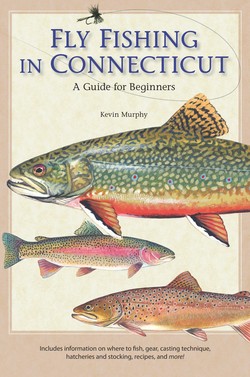Читать книгу Fly Fishing in Connecticut - Kevin Murphy - Страница 9
На сайте Литреса книга снята с продажи.
ОглавлениеTrout belong to the family Salmonidae whose members include Atlantic salmon, char, and whitefish. Members are commonly referred to as salmonids. The three most common trout—and the ones stocked in Connecticut—are rainbow, brown and brook trout. The rainbows spawn in the spring; the browns and brookies in the fall. Other fish that an angler will meet in the rivers and streams of the state include tiger trout (brown/brook hybrids that do not reproduce), and Atlantic salmon. However, this text is limited to the three trout most common in Connecticut's inland waters.
The brook trout is the only true native of the area, and is the most sought after of the three types of trout among long-time fly fishermen and fisherwomen. Thus, the expensive trips into northern Canada to catch native brookies or “squaretails.” Brookies have long streamlined bodies and a rather large mouth that extends beyond the eye. They have a silvery white belly, sides of olive-green or blue-gray, and thoroughly unique worm-like markings along their backs and on their dorsal fin. Brook trout require cool, clear, stream-fed pools.
The rainbows are the most beautiful of the three species. Their body color is dark olive or blue-green on the back, blending into a silvery blue on the underside. Reddish-pink to light tan stripes and spots run down their sides, and an eerie sheen of mother-of-pearl helps to correctly identify this fish. Rainbows range in size from nine to eighteen inches in Connecticut waters. They are ravenous eaters and have been known to eat shiners—small silvery minnows— up to a third of their length.
Brown trout (German brown trout) have large black, and sometimes reddish-orange spots on the upper half of their torsos. A pale border of silvery brown borders their lower sections, and they often present a white belly. However, brown trout colors range quite a bit more widely than those of brookies and rainbows. Generally speaking, if you catch a trout and don't see worm-like markings on its upper surfaces or reddish-pink stripes down its sides, what you have is a brown trout.
For my money, rainbows are the best fighters, perhaps because they are more acrobatic than browns or brookies. For every angler who agrees with me, there's another who likes browns and still another who prefers brookies. One man's brown is another man's brookie!
Trout have “lateral lines” down both sides of their bodies that allow them to sense barometric pressure, and alert them to approaching fish, anglers, and other possible threats. When a storm front comes in, barometric pressure falls, and these lateral lines tell the trout to start feeding. If you can arrange it, try to go fishing when the barometric pressure is dropping.
These same lateral lines alert the trout when you make a lot of noise walking and splashing in a stream, even when you are trying to be quiet. The speed of sound is more than four times faster in clear water than in air. Therefore, you might say trout are infinitely better equipped to sense you than the other way around. By working your way upstream as you fish, trout are less likely to intuit your approach.
